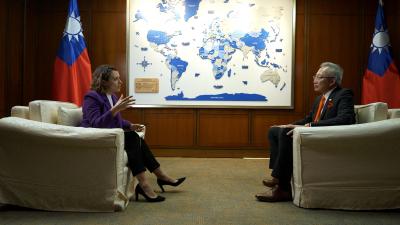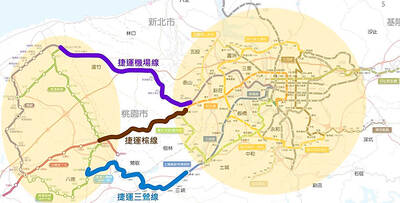The White Terror era has not been put to rest because the public still doesn’t know exactly what happened during the period and its impact can still be felt today, speakers said yesterday at a conference in Taipei on the White Terror era.
“I remember that I used to play with a group of neighbors’ kids when I was little, and one day, two brothers who always played with us just disappeared,” former Presidential Office secretary-general Chen Shih-meng (陳師孟) told the forum. “We only learned vaguely from adults that the two brothers’ father was taken away by the military police and never came home, and their mother moved away with the two kids.”
“I think many people of my age have similar memories of the White Terror [era], but we never knew how the government operated [during the period] or had an in-depth understanding of it,” he said, adding that first-hand experiences or stories like his had cast a shadow over many Taiwanese, especially when it comes to expressing political ideas.
IRON HAND
The White Terror era in Taiwan refers to a period of time when the Chinese Nationalist Party (KMT) regime — mostly under the leadership of dictator Chiang Kai-shek (蔣介石) and his son Chiang Ching-kuo (蔣經國), ruled Taiwan with an iron hand and killed or jailed thousands of political dissidents. To help the audience yesterday better understand how tightly the authoritarian regime of former dictators Chiang Kai-shek (蔣介石) and Chiang Ching-kuo (蔣經國) watched over the people, Chen Tsui-lien (陳翠蓮), a professor at National Chengchi University’s (NCCU) Graduate Institute of Taiwanese History, gave some facts from her research.
“There were secret service agencies created by the government, the military and the KMT to keep an eye on people both inside and outside their respective organizations — there was even a special overseas commission within the KMT and overseas intelligence units within Taiwan’s embassies to monitor Taiwanese activities abroad,” she said.
She said that under the Investigation Bureau alone there were more than 30,000 uniformed or underground agents spying on Taiwanese in the 1970s.
WOUNDS
“The wounds of the White Terror [era] have never fully healed — the government never conducted a thorough investigation into it, never prosecuted anyone responsible for political repression and never fully compensated the victims,” said Wellington Koo (顧立雄), a member of the Lei Chen Foundation for Democracy and Human Rights. “That’s why it [the White Terror] still has an influence on Taiwanese society and often blocks social progress even today.”
“The twisted legal system that we have today is a relic from the authoritarian period,” said NCCU Taiwanese history professor Hsueh Hua-yuan (薛化元), another panelist at the forum.
“Whether you like it or not, the Constitution of the Republic of China says that the judiciary, the executive and the legislative branches of the government have to be independent of each other,” he said. “But our courts and prosecutors — except the Supreme Court — are all under the Ministry of Justice, which is part of the executive branch.”
Hsueh said the late dictators designed the government in this way so that the executive branch could control the legal system, “and political intervention in the judiciary is still there from time to time today.”
As Taiwanese society has yet to fully recover from the wounds of the White Terror era and clean up its fallout, speakers at the conference expressed concern that the authoritarian system could make an easy comeback.
Democratic Progressive Party Chairperson Tsai Ing-wen (蔡英文) said in her speech at the forum that the government has taken many measures that violate human rights or remind people of the authoritarian past since President Ma Ying-jeou (馬英九) took office.

“China is preparing to invade Taiwan,” Deputy Minister of Foreign Affairs Francois Wu (吳志中) said in an exclusive interview with British media channel Sky News for a special report titled, “Is Taiwan ready for a Chinese invasion?” the Ministry of Foreign Affairs said today in a statement. The 25-minute-long special report by Helen Ann-Smith released yesterday saw Sky News travel to Penghu, Taoyuan and Taipei to discuss the possibility of a Chinese invasion and how Taiwan is preparing for an attack. The film observed emergency response drills, interviewed baseball fans at the Taipei Dome on their views of US President

The Central Weather Administration (CWA) today issued a "tsunami watch" alert after a magnitude 8.7 earthquake struck off the Kamchatka Peninsula in northeastern Russia earlier in the morning. The quake struck off the east coast of the Kamchatka Peninsula at 7:25am (Taiwan time) at a depth of about 19km, the CWA said, citing figures from the Pacific Tsunami Warning Center. The CWA's Seismological Center said preliminary assessments indicate that a tsunami could reach Taiwan's coastal areas by 1:18pm today. The CWA urged residents along the coast to stay alert and take necessary precautions as waves as high as 1m could hit the southeastern

ECONOMIC BENEFITS: The imports from Belize would replace those from Honduras, whose shrimp exports have dropped 67 percent since cutting ties in 2023 Maintaining ties with Taiwan has economic benefits, Ministry of Foreign Affairs officials said yesterday, citing the approval of frozen whiteleg shrimp imports from Belize by the Food and Drug Administration (FDA) as an example. The FDA on Wednesday approved the tariff-free imports from Belize after the whiteleg shrimp passed the Systematic Inspection of Imported Food, which would continue to boost mutual trade, the ministry said. Taiwan’s annual consumption of whiteleg shrimps stands at 30,000 tonnes, far exceeding domestic production, the ministry said. Taiwan used to fill the gap by importing shrimps from Honduras, but purchases slumped after Tegucigalpa severed diplomatic ties with Taiwan

The Executive Yuan yesterday approved a southwestern extension of the Sanying MRT Line from New Taipei to Bade District (八德) in Taoyuan, with a goal of starting construction by late 2026. The 4.03-kilometer extension, featuring three new stations, will run from the current terminus at Yingtao Fude Station (LB12) in New Taipei City to Dannan Station (LB14), where it will connect with Taoyuan’s Green Line, New Taipei City Metro Corp said in a statement. This extension will follow the completion of core Sanying Line, a 14.29-kilometer medium-capacity system linking Tucheng (土城), Sansia (三峽)